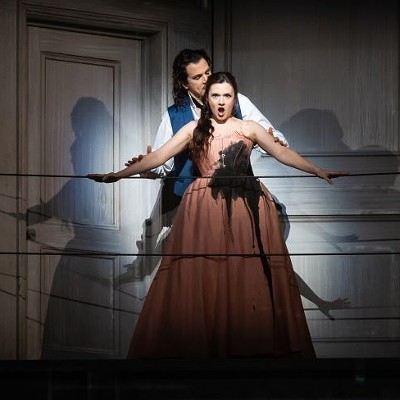As artistic partnerships go, Museum of Fine Arts, Houston Director Gary Tinterow and French artist Edgar Degas go back a long way.
Well, not exactly in a personal sense, since Degas did die in 1917, but in a collaborative sense. Tinterow was one of three organizers of a landmark 1988 Degas exhibit during his time at New York’s Metropolitan Museum of Art. He will revisit the artist’s vast work and influence with the exhibit "Degas: A New Vision."
In fact, the MFAH is the exhibit’s only U.S. stop. And of the 200 or so works on display culled from museums, private collections and public institutions, about 60 will be exclusive to Houston. In addition to the paintings for which he is best known, it will also showcase Degas’s work in drawing, printmaking, sculpture and photography.
“I had heard that my former colleague and still good friend, Henri Loyrette, had been approached by Australia to put together this exhibit. And I asked if we could participate,” Tinterow offers. Loyrette had been with the Grand Palais when the pair worked on the 1988 exhibition together, and he later became director of both the Louvre and the Musée d’Orsay.
“He knows Houston very well and was delighted to collaborate. We were able to obtain a number of loans that might not be available otherwise. I called in all my tips and pulled out all the stops in order to make the best possible exhibition for Houston.”
Degas was born in 1834, and many of his early works fell into the predictable subject matter covered by artists in his time: classical art of ancient history, mythology and the Renaissance. He also had a side gig as a copyist, respectably churning out his versions of well-known paintings.
But in the 1870s, he shifted his focus to the more contemporary, real-world subjects of Paris. Ballet and theatrical scenes, jockeys, cafe life and women bathing were favorite scenes he would revisit again and again. Even his portraits of real people tended to give them a sense of melancholy and isolation while in less formal poses. He also lived and worked for an extended stay in New Orleans.
“Those who just know Degas from his ballet paintings will be really surprised by this exhibition,” Tinterow says.
“By the breadth of his interests, the depth of his work and the psychological insight he brings to urban life and situations. And his ceaseless investigation of artistic concerns like form, line and color by using a selection of poses repeatedly. One realizes quickly that [the painting] is not just about the dancer, the jockey or the bather.”
While Degas was often lumped in with the Impressionists, he loathed the term, preferring to be called a “realist.” And indeed, his only rare uses of landscape scenes or bright colors – favorites of that school – bear that out.
“He always made his work in the studio. And he also had a painful sensitivity to bright light. So even if he wanted to work outdoors, he couldn’t,” Tinterow adds.
Later in life, Degas became deeply involved and interested in the then still-developing medium of photography. But he was never interested in the posed picture, preferring to capture his subjects off guard.
“Hardly anyone is smiling in his pictures!” Tinterow laughs.
He adds that Degas’s photos remind him of the work of Richard Avedon, who would take scores of frames of a posed subject, but ultimately choose to use or print one in which the subject is off in thought or seemingly unaware of the camera.
As for his own personal look at the exhibit strictly as an art aficionado, Tinterow says that his favorite Degas paintings in the exhibition are always changing.
While he’s enjoyed the artist’s hyperrealistic works from the early years of his shift to contemporary scenes, Tinterow has since became infatuated with Degas's later, more colorful work from the 1890s.
“They are unlike any other color combinations of any artists you’ve ever seen,” he sums up. “And when we unpack the paintings from the crate, they’re shocking. He’s using neon-orange! And neon-green! It’s just phenomenal.”
"Degas: A New Vision" opens October 16 at the Museum of Fine Arts, Houston, 1001 Bissonnet. For information. visit mfah.org or call 713-639-7300.
Support Us
Houston's independent source of
local news and culture
account
- Welcome,
Insider - Login
- My Account
- My Newsletters
- Contribute
- Contact Us
- Sign out
MFAH's Gary Tinterow Revisits an Old French Friend With "Degas: A New Vision"
Bob Ruggiero October 12, 2016 9:00AM
[
{
"name": "Related Stories / Support Us Combo",
"component": "11591218",
"insertPoint": "4",
"requiredCountToDisplay": "4"
},{
"name": "Air - Billboard - Inline Content",
"component": "11591214",
"insertPoint": "2/3",
"requiredCountToDisplay": "7"
},{
"name": "R1 - Beta - Mobile Only",
"component": "12287027",
"insertPoint": "8",
"requiredCountToDisplay": "8"
},{
"name": "Air - MediumRectangle - Inline Content - Mobile Display Size 2",
"component": "11591215",
"insertPoint": "12",
"requiredCountToDisplay": "12"
},{
"name": "Air - MediumRectangle - Inline Content - Mobile Display Size 2",
"component": "11591215",
"insertPoint": "4th",
"startingPoint": "16",
"requiredCountToDisplay": "12"
}
,{
"name": "RevContent - In Article",
"component": "12527128",
"insertPoint": "3/5",
"requiredCountToDisplay": "5"
}
]
KEEP THE HOUSTON PRESS FREE...
Since we started the Houston Press, it has been defined as the free, independent voice of Houston, and we'd like to keep it that way. With local media under siege, it's more important than ever for us to rally support behind funding our local journalism. You can help by participating in our "I Support" program, allowing us to keep offering readers access to our incisive coverage of local news, food and culture with no paywalls.
Bob Ruggiero has been writing about music, books, visual arts and entertainment for the Houston Press since 1997, with an emphasis on classic rock. He used to have an incredible and luxurious mullet in college as well. He is the author of the band biography Slippin’ Out of Darkness: The Story of WAR.
Contact:
Bob Ruggiero
Trending Arts & Culture
- Love is in the Alley's Charming Production of Brontë Classic Jane Eyre
- Fallout Successfully Makes the Transition From Video Game to Streaming Show
- Whose Story is It in The Father at 4th Wall Theatre Co.
-
Sponsored Content From: [%sponsoredBy%]
[%title%]

Don't Miss Out
SIGN UP for the latest
arts & culture
news, free stuff and more!
Become a member to support the independent voice of Houston
and help keep the future of the Houston Press FREE
Use of this website constitutes acceptance of our
terms of use,
our cookies policy, and our
privacy policy
The Houston Press may earn a portion of sales from products & services purchased through links on our site from our
affiliate partners.
©2024
Houston Press, LP. All rights reserved.





